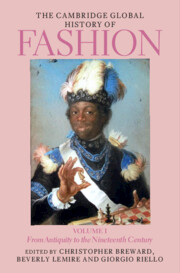Book contents
- The Cambridge Global History of Fashion
- The Cambridge Global History of Fashion
- The Cambridge Global History of Fashion
- Copyright page
- Contents for Volume I
- Figures for Volume I
- Maps for Volume I
- Table for Volume I
- Contributors for Volume I
- Preface
- 1 Global History in the History of Fashion
- Part I Multiple Origins of Fashion
- Part II Early Modern Global Entanglements
- 7 Magnificence at the Royal Courts in the Islamic World
- 8 Early Modern Fashion Cities
- 9 Fashioning Possibilities
- 10 Fashion Beyond Clothing
- 11 Fashion and the Maritime Empires
- 12 Garments of Servitude, Fabrics of Freedom
- Part III Many Worlds of Fashion
- Index
- References
10 - Fashion Beyond Clothing
Early Modern Visual Culture of Eurasian Dress
from Part II - Early Modern Global Entanglements
Published online by Cambridge University Press: 04 August 2023
- The Cambridge Global History of Fashion
- The Cambridge Global History of Fashion
- The Cambridge Global History of Fashion
- Copyright page
- Contents for Volume I
- Figures for Volume I
- Maps for Volume I
- Table for Volume I
- Contributors for Volume I
- Preface
- 1 Global History in the History of Fashion
- Part I Multiple Origins of Fashion
- Part II Early Modern Global Entanglements
- 7 Magnificence at the Royal Courts in the Islamic World
- 8 Early Modern Fashion Cities
- 9 Fashioning Possibilities
- 10 Fashion Beyond Clothing
- 11 Fashion and the Maritime Empires
- 12 Garments of Servitude, Fabrics of Freedom
- Part III Many Worlds of Fashion
- Index
- References
Summary
The ‘visuality’ of fashion conjures up thoughts of directional garments, spectacular catwalks, and the fashion image. The term ‘visuality’ was coined by Thomas Carlyle in the 1830s to capture his conservative view of British imperial history as a series of ‘vivid pictures’ exceeding archival facts. It took on a very different resonance within late twentieth-century post-modernism when it came to mean ways of seeing, ‘sight as a social fact’, and the ‘politics of representation in transnational and transcultural form’.1 Fashion studies has been dominated by this discursive mode of analysing the fashion image via the insistence of Roland Barthes and Jean Baudrillard on ‘written fashion’ within twentieth-century media: printed page, photograph, simulation, and copy. This approach tends to obscure the different work and connotation of fashion before modernism, although early modern prints and drawings of dress often resorted to words to convey the colours, textures, and materialities of dress.
- Type
- Chapter
- Information
- The Cambridge Global History of FashionFrom Antiquity to the Nineteenth Century, pp. 314 - 362Publisher: Cambridge University PressPrint publication year: 2023



